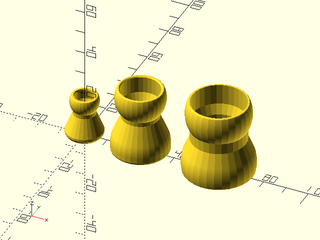This file contains Unicode characters that might be confused with other characters. If you think that this is intentional, you can safely ignore this warning. Use the Escape button to reveal them.
LibFile: modular_hose.scad
Modular hose segment and attachment ends.
To use, add the following lines to the beginning of your file:
include <BOSL2/std.scad>
include <BOSL2/modular_hose.scad>
File Contents
- Section: Modular Hose Parts
modular_hose()– Creates modular hose parts.modular_hose_radius()– Returns the waist radius of the given modular hose size.
Section: Modular Hose Parts
Module: modular_hose()
Synopsis: Creates modular hose parts.
Topics: Modular Hose, Parts
See Also: modular_hose_radius(), tube()
Usage:
- modular_hose(size, type, [clearance], [waist_len], [anchor], [spin], [orient]) [ATTACHMENTS];
Description:
Construct moduler hose segments or modular hose ends for connection to standard modular hose systems. The 1/4", 1/2" and 3/4" sizes are supported and you can produce just one end to make a mount or end attachment to a modular hose, or you can make modular hose segments. To make assembly possible with printed parts you can add clearances that make the ball end smaller and the socket end larger. These work by simply increasing the radius of the whole end by the specified amount. On a Prusa printer with PETG, a clearance of 0.05 allows the 3/4" hose parts to mate with standard modular hose or itself. A clearance of 0.05 to 0.1 allows the 1/2" parts to mate with standard hose, and with clearance 0 the 1/4" parts will mate with standard hose. Note that clearance values are different for the different sizes. You will have to experiment with your machine and materials. Small adjustments will change the stiffness of the connection.
Arguments:
| By Position | What it does |
|---|---|
size |
size of modular hose part, must be 1/4, 1/2 or 3/4. |
type |
type of part to make, either "segment", "socket" (or "big"), or "ball" (or "small") |
clearance |
clearance to make assembly possible. Either a scalar to apply the same to both ends or a vector [small,large] to apply different clearances to the two ends. Default: 0 |
waist_len |
size of central "waist" of the part. Default: standard length. |
Example 1:

include <BOSL2/std.scad>
include <BOSL2/modular_hose.scad>
modular_hose(1/4,"segment");
right(25)modular_hose(1/2,"segment");
right(60)modular_hose(3/4,"segment");
Example 2: A mount point for modular hose

include <BOSL2/std.scad>
include <BOSL2/modular_hose.scad>
cylinder(h=10, r=20)
attach(TOP) modular_hose(1/2, "ball", waist_len=15);
Example 3: Mounting plate for something at the end of the hose

include <BOSL2/std.scad>
include <BOSL2/modular_hose.scad>
cuboid([50,50,5])
attach(TOP) modular_hose(3/4, "socket", waist_len=0);
Function: modular_hose_radius()
Synopsis: Returns the waist radius of the given modular hose size.
Topics: Modular Hose, Parts
See Also: modular_hose(), tube()
Usage:
- r = modular_hose_radius(size, [outer]);
Description:
Returns the inner (or outer) diameter of the waist section of the modular hose to enable hollowing out connecting channels. Note: diameter is accurate to about 1e-4.
Arguments:
| By Position | What it does |
|---|---|
size |
size of hose part, must be 1/4, 1/2 or 3/4 |
outer |
set to true to get the outer diameter. |
Example 1:

include <BOSL2/std.scad>
include <BOSL2/modular_hose.scad>
$fn=64;
back_half()
diff("remove")
cuboid(50){
attach(TOP) modular_hose(1/2, "ball");
up(0.01)position(TOP+RIGHT)tag("remove")
rot(180)
xrot(-90)
rotate_extrude(angle=135)
right(25)
circle(r=modular_hose_radius(1/2));
}
Indices
Table of Contents
Function Index
Topics Index
Cheat Sheet
Tutorials
List of Files:
Basic Modeling:
- constants.scad STD
- transforms.scad STD
- attachments.scad STD
- shapes2d.scad STD
- shapes3d.scad STD
- drawing.scad STD
- masks2d.scad STD
- masks3d.scad STD
- distributors.scad STD
- color.scad STD
- partitions.scad STD
- miscellaneous.scad STD
Advanced Modeling:
- paths.scad STD
- regions.scad STD
- skin.scad STD
- vnf.scad STD
- beziers.scad
- nurbs.scad
- rounding.scad
- turtle3d.scad
Math:
- math.scad STD
- linalg.scad STD
- vectors.scad STD
- coords.scad STD
- geometry.scad STD
- trigonometry.scad STD
Data Management:
- version.scad STD
- comparisons.scad STD
- lists.scad STD
- utility.scad STD
- strings.scad STD
- structs.scad STD
- fnliterals.scad
Threaded Parts:
Parts:
- ball_bearings.scad
- cubetruss.scad
- gears.scad
- hinges.scad
- joiners.scad
- linear_bearings.scad
- modular_hose.scad
- nema_steppers.scad
- polyhedra.scad
- sliders.scad
- tripod_mounts.scad
- walls.scad
- wiring.scad
Footnotes:
STD = Included in std.scad